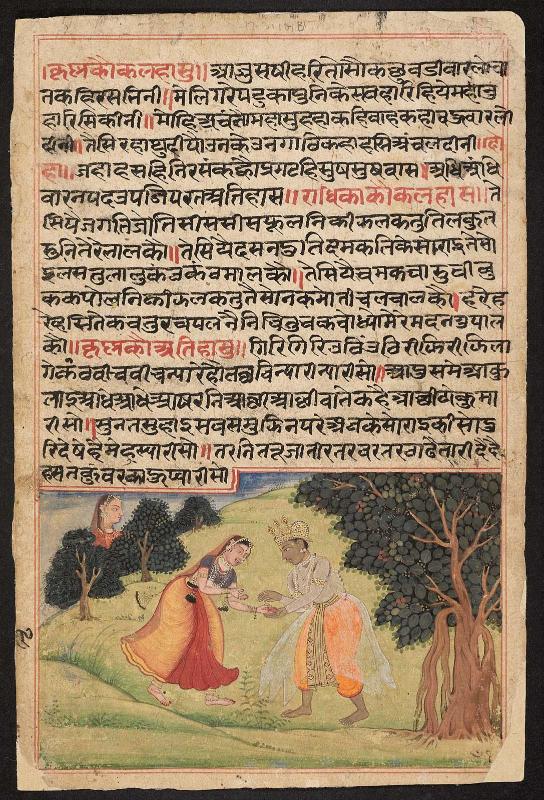Keshava Das's "Rasikapriya": Radha's Smile
about 1615
Object PlaceNorthern India
Medium/TechniqueInk, watercolor, and gold on paper
DimensionsHeight x width: 22.6 × 15 cm (8 7/8 × 5 7/8 in.)
Credit LineRoss-Coomaraswamy Collection
Accession number17.3110
On View
Not on viewClassificationsBooks and manuscripts
Collections
Keshava Das composed the romantic poem called the Rasikapriya ("Connoisseur's Delights") in 1591 in the Central Indian kingdom of Orchha. Written in Braj Basha, it is an important work of Indian vernacular literature. Extremely popular even within the first few decades of its writing, the Rasikapriya was illustrated many times by artists of differing backgrounds. The copy to which this page belongs, which is colloquially known as the "Boston" Rasikapriya because there are 29 pages in the collection of the MFA, was produced in the early seventeenth century. The relatively naturalistic style of the illustrations and the vertical format of the pages suggests that it was created within the orbit of the Mughal court, and the vernacular text and its content - about Krishna and his lovers - suggest a Hindu patron. Approximately 60 pages from this dispersed manuscript are known today.
InscriptionsInscription in front: Hindi text, headed with the title "Radhika kau mamdahasu = Radha's smile." (AKC provides entire translation) Corresponds to verses 6-9. This is folio 70 of the manuscript.. Inscription in back: Hindi text, headed with the title "Krsna kau kalahasa = Krishna's low laugh" (AKC provides rest of verse).ProvenanceBy 1916, purchased in India by Ananda K. Coomaraswamy (b. 1887 - d. 1947); 1917, sold by Ananda K. Coomaraswamy to Denman Waldo Ross (b. 1853 - d. 1935), Cambridge, MA; 1917, given by Denman Waldo Ross to the MFA. (Accession date: April 5, 1917)
second half of 15th century
Probably 16th century















